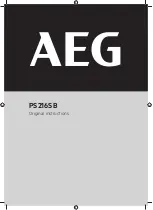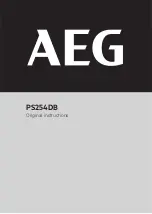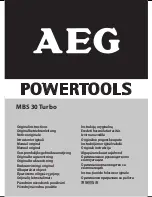
10
GB
k) Keep bystanders a safe distance away from work area. Anyone entering the work
area must wear personal protective equipment. Fragments of workpiece or of a
broken wheel may fly away and cause injury beyond immediate area of operation.
l) Hold the power tool by insulated gripping surfaces only, when performing an
operation where the cutting accessory may contact hidden wiring or its own cord.
Cutting accessory contacting a ‘live’ wire may make exposed metal parts of the power tool
‘live’ and could give the operator an electric shock.
m) Position the cord clear of the spinning accessory. If you lose control, the cord may be
cut or snagged and your hand or arm may be pulled into the spinning wheel.
n) Never lay the power tool down until the accessory has come to a complete stop. The
spinning wheel may grab the surface and pull the power tool out of your control.
o) Do not run the power tool while carrying it at your side. Accidental contact with the
spinning accessory could snag your clothing, pulling the accessory into your body.
p) Regularly clean the power tool’s air vents. The motor’s fan will draw the dust inside the
housing and excessive accumulation of powdered metal may cause electrical hazards.
q) Do not operate the power tool near flammable materials. Sparks could ignite these
materials.
r) Do not use accessories that require liquid coolants. Using water or other liquid coolants
may result in electrocution or shock.
Kickback and related warnings
Kickback is a sudden reaction to a pinched or snagged rotating wheel. Pinching or snagging
causes rapid stalling of the rotating wheel, which in turn causes the uncontrolled power tool to
be forced in the direction opposite of the wheel’s rotation at the point of the binding.
For example, if an abrasive wheel is snagged or pinched by the workpiece, the edge of the
wheel that is entering into the pinch point can dig into the surface of the material, causing the
wheel to climb out or kick out. The wheel may either jump toward or away from the operator,
depending on the direction of the wheel’s movement at the point of pinching. Abrasive wheels
may also break under these conditions.
Kickback is the result of power tool misuse and/or incorrect operating procedures or
conditions and can be avoided by taking proper precautions as given below.
a) Maintain a firm grip on the power tool and position your body and arm to allow you
to resist kickback forces. Always use auxiliary handle, if provided, for maximum
control over kickback or torque reaction during start-up. The operator can control
torque reactions or kickback force if proper precautions are taken.
b) Never place your hand near the rotating accessory. Accessory may kickback over
your hand.
c) Do not position your body in line with the rotating wheel. Kickback will propel the tool
in direction opposite to the wheel’s movement at the point of snagging.
d) Use special care when working corners, sharp edges etc. Avoid bouncing and
snagging the accessory. Corners, sharp edges or bouncing have a tendency to snag
the rotating accessory and cause loss of control or kickback.
e) Do not attach a saw chain, woodcarving blade, segmented diamond wheel with a
peripheral gap greater than 10mm or toothed saw blade. Such blades create frequent
kickback and loss of control.
f) Do not ‘jam’ the wheel or apply excessive pressure. Do not attempt to make an
excessive depth of cut. Overstressing the wheel increases the loading and susceptibility
to twisting or binding of the wheel in the cut and the possibility of kickback or wheel
breakage.
g) When wheel is binding or when interrupting a cut for any reason, switch off the
power tool and hold the power tool motionless until the wheel comes to a complete
stop. Never attempt to remove the wheel from the cut while the wheel is in motion
otherwise kickback may occur. Investigate and take corrective action to eliminate the
cause of wheel binding.
h) Do not restart the cutting operation in the workpiece. Let the wheel reach full speed
and carefully re-enter the cut. The wheel may bind, walk up or kickback if the power
tool is restarted in the workpiece.
i) Support panels or any oversized workpiece to minimise the risk of wheel pinching
and kickback. Large workpieces tend to sag under their own weight. Supports must
be placed under the workpiece near the line of cut and near the edge of the workpiece on
both sides of the wheel.
j) Use extra caution when making a ‘pocket cut’ into existing walls or other blind areas.
The protruding wheel may cut gas or water pipes, electrical wiring or objects that can
cause kickback.
Additional safety for super abrasives
• Superabrasives are generally inflexible and could shatter, so must be handled with
the utmost care. Damaged or improperly mounted superabrasives are dangerous and
can cause SEVERE injury to the user and other people in the vicinity
• Types of superabrasive wheels include diamond cutting discs, welded metal discs,
CBN discs etc. Choose your superabrasive tool carefully, taking into consideration the
workpiece material, the machine dimensions and capabilities. Make sure the machine
does not exceed the maximum operating speed of the superabrasive disc
• NEVER use superabrasive cutting discs for side grinding, as this might lead to the
disc shattering
• Superabrasive wheels have to be carefully inspected and tested before mounting.
Metal wheels should be subjected to a sound test: hold the wheel on a mandrel or with
a finger inserted through the bore, then tap it with a non-metallic object at several points
and listen each time to the sound produced. An intact wheel will produce a clear ‘bell like’
metallic sound. Damaged wheels will give a dull, chattering sound. If in doubt, DO NOT
USE, MARK AS DAMAGED AND DISCARD
• Make sure the machine’s mounting flange is compatible with the superabrasive
wheel. Refer to the manufacturer’s mounting instructions
• ALWAYS conduct a test run after mounting, with no load for at least 30 seconds,
to determine if the wheel runs balanced and does not produce excessive vibration.
If it does, switch off IMMEDIATELY, remove the disc, inspect, re-mount and re-test if no
damage is detected
• If planning on using the superabrasive wheel with a coolant, liquid dust
suppressant or lubricant, first check if the wheel, machine and workpiece are
compatible with wet cutting and with the compound to be used. Always apply liquid
to an already running wheel, never to a non-moving tool, as the unbalance could lead
to the rupture of the wheel. When switching off, remove the liquid supply first and let the
machine run at no-load, until centrifugal forces have drained all liquid from the wheel. Dry
off the wheel after use, and prevent liquid from being absorbed into the wheel
936962_Z1MANPRO1.indd 10
06/10/2015 16:55











































